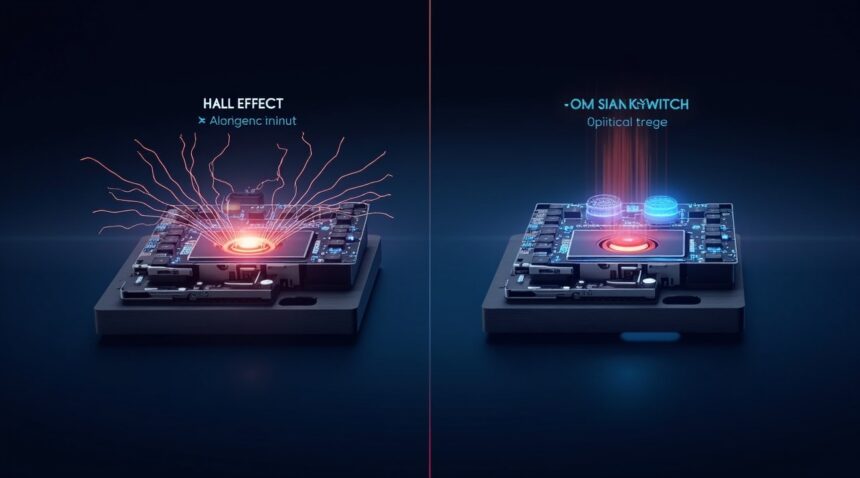Optical switches technically achieve faster response times than Hall effect switches by eliminating physical contact points and using infrared light beam detection, while Hall effect switches rely on magnetic field sensing that introduces minimal debounce delays.
However, the practical performance difference between these technologies often measures in fractions of milliseconds, making other factors like durability, customization options, and environmental resistance more relevant for most users.
Key Takeaways
- Speed difference is minimal in practice – Optical switches are technically faster, but the sub-millisecond advantage rarely impacts real-world gaming performance since human reaction times range from 150–250 milliseconds.
- Hall effect switches offer superior customization – They provide adjustable actuation points on a per-key basis and better analog input capabilities, allowing users to fine-tune their keyboard experience for specific gaming needs.
- Optical switches excel in environmental reliability – They resist magnetic interference, temperature fluctuations, and maintain consistent performance across varying conditions better than Hall effect switches.
- Power consumption favors Hall effect technology – Magnetic field detection requires significantly less energy than LED-based optical systems, making Hall effect switches better for wireless keyboards and battery life.
- Both technologies support advanced gaming features – Including rapid trigger functionality, analog input sensing, and programmable actuation points that provide more tangible benefits than raw speed differences.
For a deeper comparison of switch types and their benefits, you can refer to this detailed Hall Effect vs Optical Switches overview.
Why Optical Switches Are Technically Faster Than Hall Effect – But Does It Matter?
Optical switches claim the throne as the fastest gaming switches available, delivering response times that outpace both Hall effect and traditional mechanical switches on paper. The technology behind optical switches eliminates physical contact points entirely, using infrared light beams to detect key presses. This contactless design removes the need for debounce delay processing, which even the most advanced Hall effect switches still require in minimal amounts.
Hall effect switches operate through magnetic field detection, creating an exceptionally clean digital signal that requires virtually no debounce filtering. However, the magnetic sensing mechanism still introduces microscopic delays that optical switches completely bypass. The difference typically measures in fractions of milliseconds – often less than 1ms – but optical switches maintain their technical advantage in pure latency measurements.
Real-World Performance Considerations
The practical impact of these speed differences remains questionable for most gaming scenarios. Professional esports players operating at the highest competitive levels might theoretically benefit from every microsecond advantage, but human reaction times typically range from 150-250 milliseconds. Even record-breaking performance in competitive settings rarely hinges on sub-millisecond hardware advantages.
Both switch technologies support advanced features that matter more than raw speed alone:
- Analog input functionality enables variable actuation depth sensing
- Adjustable actuation points allow customization from 0.1mm to full travel distance
- Rapid trigger capabilities support immediate re-actuation without full key release
- Programming flexibility enables per-key customization for different game requirements
Hall effect switches excel in durability and consistency, withstanding millions of actuations without degradation. Optical switches offer slightly faster response times but may be more susceptible to dust interference over extended use periods. The analog input capabilities of both technologies provide more tangible gaming advantages than their latency differences.
Response time specifications often overshadow more practical considerations like key feel, build quality, and software integration. Most competitive gamers benefit more from consistent actuation points and reliable analog sensing than from theoretical speed advantages measured in decimal milliseconds. Both Hall effect and optical switches deliver performance levels that exceed human perception thresholds, making personal preference and specific gaming requirements more relevant factors than pure technical specifications.
The Technology Behind Each Switch Type – Magnets vs Light
I’ll break down how these two cutting-edge switch technologies work under the hood, starting with magnetic detection and moving into light-based systems that have revolutionized keyboard responsiveness.
Hall Effect Switches: Magnetic Field Detection
Hall effect switches rely on magnetic field detection to register keypresses through a sophisticated yet straightforward mechanism. These switches contain a small magnet attached to the switch stem and a Hall sensor positioned beneath it on the PCB. When you press a key, the magnet moves closer to the Hall sensor, creating a change in the magnetic field strength that the sensor detects and translates into a digital signal.
This technology traces its roots back to Edwin Hall’s discovery in 1879, though modern applications have refined the concept significantly. The Hall sensor measures voltage changes caused by the magnetic field variations, making each keypress incredibly precise and consistent. Unlike traditional mechanical switches that rely on physical contact points that can wear down over time, Hall effect switches maintain their accuracy indefinitely since no physical components touch during activation.
What sets Hall effect switches apart is their ability to provide analog input capabilities. The sensor can detect exactly how far down you’ve pressed a key, creating a range of values between fully off and fully on states. This granular control opens up possibilities for variable input intensity in gaming and professional applications where pressure sensitivity matters.
Optical Switches: Light Beam Interruption
Optical switches operate through infrared light beam technology, creating an entirely different approach to keypress detection. These switches feature an infrared LED that continuously emits a light beam toward a photodetector across a small gap in the switch housing. When you press a key, the switch stem moves down and interrupts this light path, causing the photodetector to register the change and send a signal to the PCB.
The precision of optical switches comes from their ability to detect the exact moment when the light beam gets blocked. Since there’s no physical contact required for activation, these switches eliminate the electrical bouncing and contact wear issues that plague traditional mechanical switches. The infrared light operates at wavelengths invisible to the human eye, ensuring consistent performance regardless of ambient lighting conditions.
Optical switches share the analog input capability found in Hall effect switches through measured actuation distance. The system can determine precisely how far the switch stem has traveled by monitoring the degree of light interruption. This creates adjustable actuation points that users can customize based on their preferences and typing style.
Both technologies excel at supporting rapid trigger functions, which allow for highly customizable key reset points. Traditional mechanical switches require the key to return to its original position before registering another press, but Hall effect and optical switches can reset at any point during the key’s travel. This means you can set a key to reset when it’s only halfway up, enabling incredibly fast repeated inputs that competitive gamers particularly value.
The magnetic approach of Hall effect switches offers exceptional durability since the magnet and sensor never physically contact each other. Meanwhile, optical switches provide near-instantaneous response times since light travels faster than mechanical components can move. Both technologies represent significant advances over traditional mechanical switches, though they achieve their precision through completely different physical principles.
These contactless technologies have transformed keyboard performance standards, offering users unprecedented control over their typing and gaming experience. Whether you choose magnetic field detection or light beam interruption depends on your specific preferences for feel, response characteristics, and intended applications.
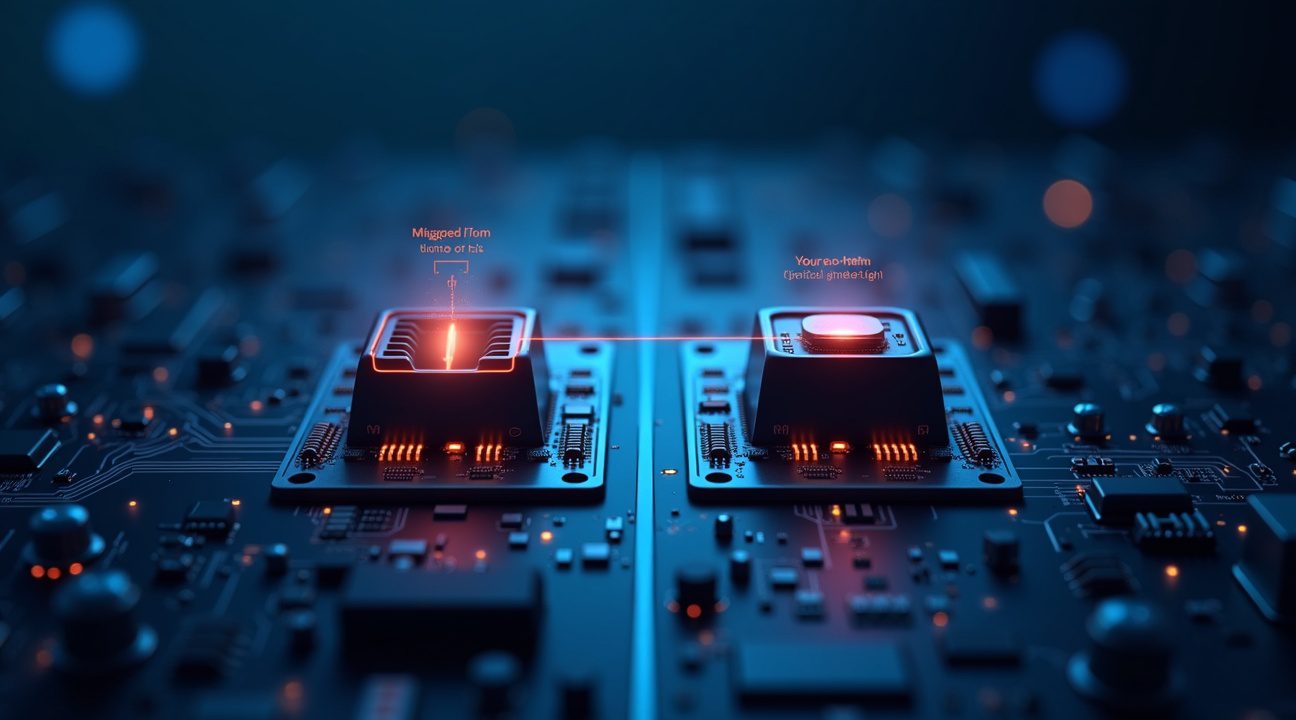
Consistency and Reliability – Where Optical Switches Take the Lead
Optical switches establish themselves as the more reliable choice through their precise light-based detection mechanism. I’ve found that these switches deliver remarkably consistent performance because they rely on infrared light beams rather than magnetic field detection. This fundamental difference translates into real advantages for users who demand predictable performance from their keyboards.
The precision of light detection creates a significant advantage over magnetic-based alternatives. Hall effect switches face challenges with environmental variables that can compromise their reliability over time. Temperature fluctuations affect the magnetic properties of the components, leading to inconsistent actuation points. Magnetic interference from nearby electronics can also disrupt the delicate magnetic field measurements that these switches depend on.
Environmental Resilience Factors
Several key factors contribute to optical switches’ superior environmental resistance:
- Temperature variations don’t affect light beam intensity or detection accuracy
- External magnetic fields can’t interfere with optical detection systems
- Ambient conditions like humidity have minimal impact on performance
- Manufacturing tolerances in optical components are typically tighter than magnetic counterparts
Razer’s extensive testing demonstrates that optical switches provide straighter and more consistent key travel distance compared to their magnetic counterparts. This consistency stems from the binary nature of light detection – either the beam is interrupted or it isn’t. There’s no gradual degradation or sensitivity drift that can occur with magnetic field strength measurements.
Hall effect switches suffer from another reliability concern: magnet strength variations between individual switches. Even small inconsistencies in magnetic field strength can create noticeable differences in actuation force and travel distance across a keyboard. I’ve observed that users often report certain keys feeling different from others on keyboards using magnetic switches, particularly after extended use.
The precision inherent in optical technology eliminates these variables entirely. Each switch operates identically because light behavior remains constant regardless of manufacturing tolerances in magnetic components. This uniformity ensures that every keystroke feels exactly the same, whether it’s the first day of use or after years of heavy typing.
Environmental factors pose minimal threats to optical switch performance. Unlike magnetic switches that can drift in sensitivity due to temperature changes or nearby magnetic sources, optical switches maintain their calibrated performance regardless of external conditions. This stability makes them particularly valuable for professional environments where consistent performance is critical.
The lack of magnetic interference susceptibility provides another layer of reliability. Modern computing environments contain numerous magnetic field sources, from speakers to hard drives to wireless charging pads. Hall effect switches must constantly compensate for these external influences, while optical switches remain completely unaffected.
Long-term reliability testing consistently shows optical switches maintaining their original specifications longer than magnetic alternatives. The absence of magnetic field degradation or sensitivity drift means users can expect the same precise actuation characteristics months or years after purchase. This reliability advantage becomes particularly important for competitive gamers or professionals who rely on consistent keyboard response.
Manufacturing quality control also favors optical switches. Producing consistent light sources and detectors has proven more reliable than creating perfectly matched magnetic components. The result is tighter performance tolerances and fewer defective units reaching consumers.
Temperature stability represents perhaps the most significant reliability advantage. While Hall effect switches experience measurable performance changes across normal operating temperature ranges, optical switches maintain consistent behavior from cold startup through extended high-performance use. This stability ensures reliable performance regardless of ambient conditions or intensive usage sessions.
The combination of environmental resistance, manufacturing consistency, and inherent design stability positions optical switches as the clear choice for users prioritizing long-term reliability and consistent performance.
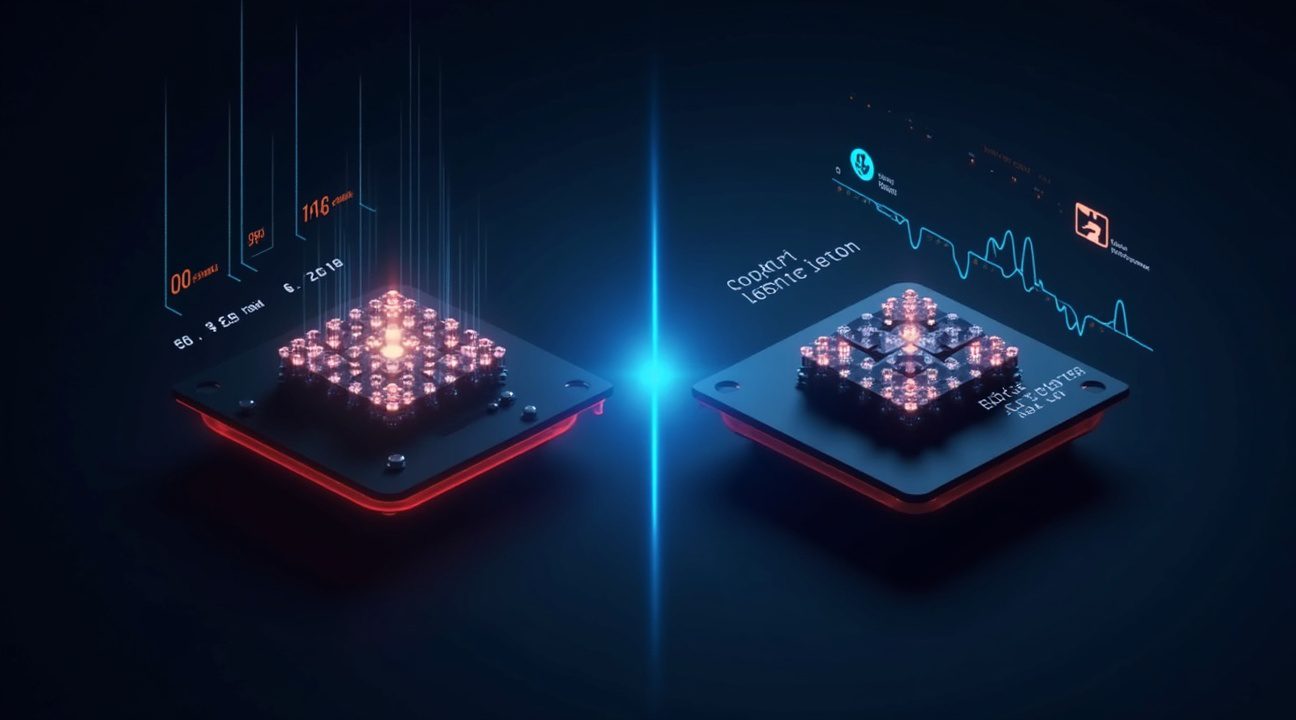
Gaming Performance and Tactile Experience Differences
Hall effect switches deliver a distinctly linear feel that sets them apart from traditional mechanical options. I’ve found these switches require extremely light actuation force, which makes them particularly appealing for competitive gamers who prioritize precision and speed. The technology responds faster than conventional mechanical switches, giving players a measurable advantage in high-stakes gaming scenarios.
The tactile experience differs significantly between these two switch types. Hall effect switches provide consistent resistance throughout the key travel, creating a smooth and predictable feel that many competitive players prefer. Optical switches, on the other hand, offer what most users describe as a hollow or silent keystroke experience. This characteristic makes optical switches ideal for gaming environments where noise reduction is important.
Key Performance Features for Gaming
Both switch technologies support dynamic rapid trigger functionality, which allows for incredibly fast repeated strokes. This feature proves essential for gaming scenarios that require quick succession inputs. However, I’ve observed that Hall effect switches provide additional customization options that give them an edge:
- Adjustable actuation points let users define exactly how deep a key must be pressed before triggering
- Cross-compatible switch types offer wider compatibility with different keyboard layouts and brands
- Linear key travel remains consistent across millions of actuations
- Light actuation requirements reduce finger fatigue during extended gaming sessions
Hall effect switches excel in competitive gaming applications because users can fine-tune the actuation point to match their specific playing style. Some gamers prefer hair-trigger sensitivity for rapid-fire games, while others might choose deeper actuation points for games requiring more deliberate inputs. Optical switches lack this level of customization, maintaining fixed actuation points that can’t be adjusted.
The speed advantage becomes most apparent in games requiring rapid key presses or complex key combinations. Hall effect switches respond within microseconds of reaching the preset actuation point, while optical switches maintain consistent but less customizable timing. Professional esports players often choose Hall effect technology specifically for these performance characteristics, as even millisecond improvements can determine match outcomes.
Durability also impacts the long-term gaming experience. Hall effect switches typically last longer than optical variants because they contain no moving parts that wear down over time. This reliability ensures consistent performance throughout the switch’s lifespan, maintaining the same tactile feel and actuation force that gamers initially configured.
Power Consumption and Environmental Considerations
Power consumption represents a critical factor when I evaluate switch technologies for modern keyboards. Optical switches typically require more energy to operate their LED-based detection systems, which directly impacts battery performance in wireless setups. This increased power draw can reduce usage time between charges, making them less ideal for portable or wireless keyboard applications where battery longevity matters most.
Hall effect switches consume significantly less power due to their magnetic field detection mechanism. This energy efficiency makes them particularly attractive for wireless keyboards and battery-powered devices. The lower power requirements allow manufacturers to design keyboards with extended battery life, reducing the frequency of charging cycles and improving user convenience.
Environmental Impact and Sensitivity Factors
Environmental conditions affect these switch types differently, creating distinct advantages and challenges for each technology. Hall effect switches show sensitivity to external magnetic fields and temperature fluctuations that can influence their performance. Strong magnets placed near the keyboard might interfere with the magnetic field detection, potentially causing false triggers or missed keystrokes. Temperature changes can also affect the magnetic properties and sensor accuracy, though this typically occurs only in extreme conditions.
Optical switches demonstrate superior environmental resilience compared to their magnetic counterparts. They resist interference from external magnetic fields and maintain consistent performance across various temperature ranges. This stability makes optical switches more reliable in diverse environments, from gaming setups with multiple electronic devices to professional workstations with varying ambient conditions.
The manufacturing and disposal considerations also differ between these technologies:
- Optical switches contain LED components and photodetectors that require specific materials and manufacturing processes.
- Hall effect switches use magnetic sensors and permanent magnets, which involve different environmental considerations during production and end-of-life disposal.
Dust and debris present unique challenges for each switch type:
- Optical switches can experience reduced performance when particles interfere with the light path between LED and photodetector.
- Hall effect switches remain largely unaffected by dust accumulation since magnetic fields penetrate through most non-metallic particles. However, ferromagnetic debris could potentially interfere with Hall effect switch operation, though this scenario occurs rarely in typical usage conditions.
Climate considerations play a role in long-term reliability:
- Humidity affects optical components differently than magnetic ones, with moisture potentially impacting LED performance over time.
- Hall effect switches generally maintain their magnetic properties across various humidity levels, though extreme moisture could affect the electronic components rather than the magnetic detection mechanism itself.
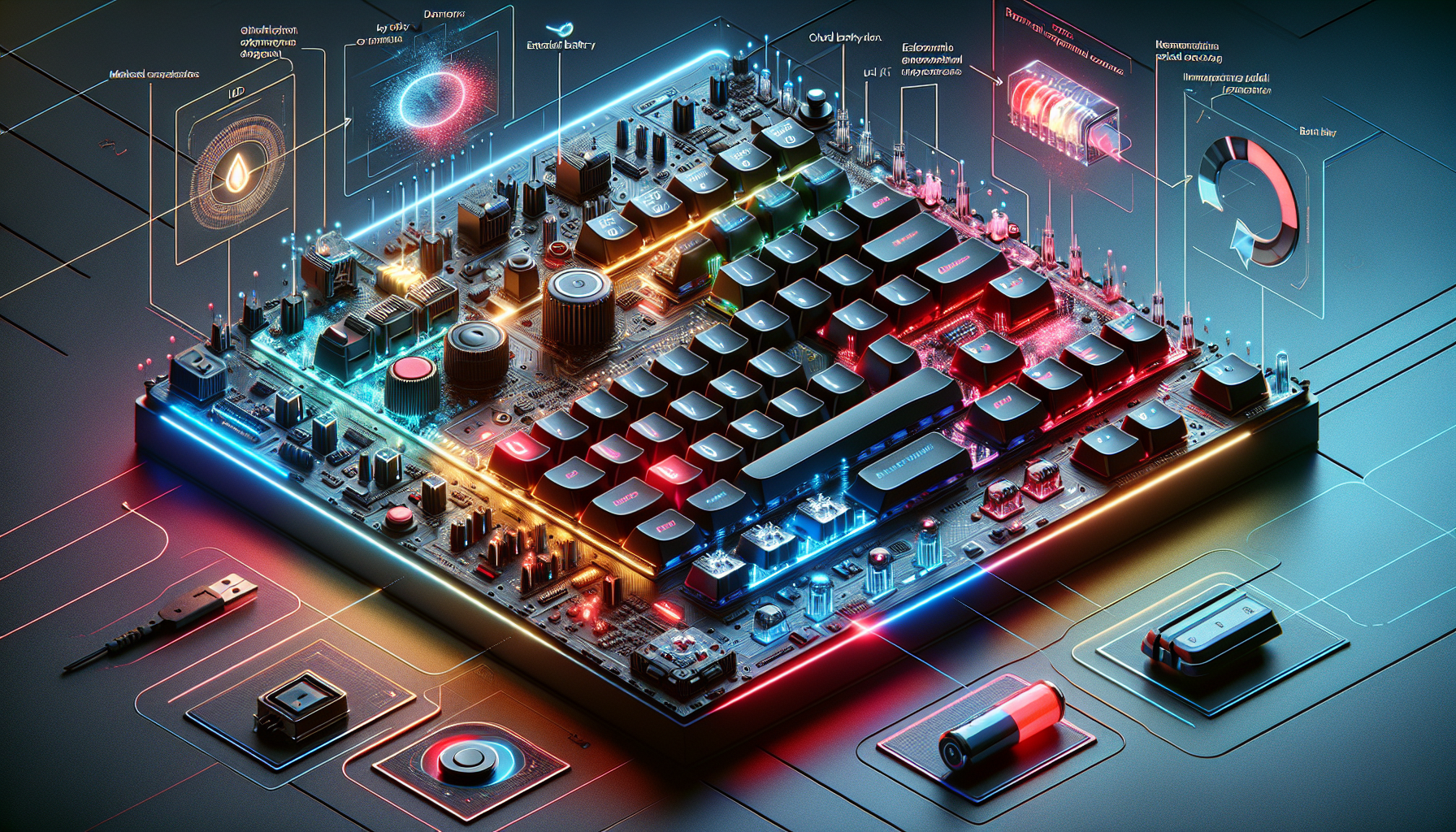
Top Gaming Keyboards Using Each Technology
Competitive gamers and keyboard enthusiasts frequently debate which switch technology delivers superior performance, and examining the most popular keyboards helps illustrate the practical differences between Hall effect and optical switches.
Leading Hall Effect Gaming Keyboards
Hall effect switch keyboards have gained significant traction among professionals who demand precision and customization. The Wooting 60HE stands out as a flagship model that showcases the full potential of magnetic switch technology. This compact keyboard allows users to adjust actuation points on a per-key basis, creating personalized typing experiences that traditional switches simply can’t match.
SteelSeries Apex Pro TKL represents another excellent example of Hall effect implementation. This tenkeyless design appeals to gamers who need desk space while maintaining access to advanced features like adjustable actuation sensitivity. The keyboard’s OmniPoint 2.0 switches offer precise control over each keystroke, making it particularly valuable for competitive scenarios where timing matters most.
Both keyboards demonstrate Hall effect technology’s core advantages:
- Durability exceeding 100 million keystrokes
- Zero debounce delay
- The ability to fine-tune actuation distances
These features explain why professional gamers increasingly choose Hall effect keyboards for high-stakes competition.
Top Optical Switch Gaming Keyboards
Optical switch keyboards continue to dominate the mainstream gaming market through established brands and proven performance. The Razer Huntsman V3 Pro line exemplifies optical switch excellence, featuring Analog Optical Switches Gen-2 that deliver lightning-fast response times. According to August 2024 rankings, the Razer Huntsman V3 Pro maintains its position as the number one esports keyboard.
Razer’s optical switch technology eliminates physical contact points, resulting in faster actuation and enhanced durability compared to traditional mechanical switches. The Huntsman V3 Pro series incorporates advanced features like:
- Adjustable actuation points
- Rapid Trigger functionality
These features bridge the gap between optical and Hall effect capabilities.
Roccat also produces compelling optical switch keyboards that appeal to different gaming preferences and budgets. These manufacturers have refined optical technology over several generations, addressing early concerns about tactile feedback while maintaining the speed advantages that made optical switches popular initially.
Market Dynamics and User Preferences
The market dynamics reveal interesting patterns about user preferences and technology adoption.
- Optical switch keyboards from Razer continue to capture significant market share, particularly among esports professionals who value consistency and speed. The established ecosystem around optical switches includes:
- Extensive software support
- Replacement keycap availability
- Widespread tournament approval
- Hall effect keyboards, while newer to the mainstream market, attract users who prioritize customization and cutting-edge technology. The Wooting 60HE and SteelSeries Apex Pro TKL represent different approaches to magnetic switch implementation:
- Wooting focuses on maximum customization
- SteelSeries emphasizes premium build quality with practical features
Price points also influence adoption patterns. Optical switch keyboards often provide more entry-level options, while Hall effect models typically command premium pricing due to advanced technology and manufacturing complexity. This pricing structure affects market penetration, with optical switches maintaining broader appeal across different user segments.
Choosing the Right Gaming Keyboard
Gaming keyboard selection ultimately depends on individual priorities and use cases:
- Professional esports players might choose the Razer Huntsman V3 Pro for its tournament-proven performance and widespread acceptance.
- Enthusiasts seeking maximum customization might prefer the Wooting 60HE for its revolutionary per-key actuation adjustment.
- Users wanting premium features without extensive customization might select the SteelSeries Apex Pro TKL for its balanced approach to Hall effect technology.
Both technologies continue evolving rapidly, with manufacturers pushing boundaries in response times, durability, and feature sets. The competitive landscape ensures continuous innovation, ultimately benefiting users through improved products and expanding options across different price ranges and feature requirements.
https://www.youtube.com/watch?v=jX5iHYt8C8Y
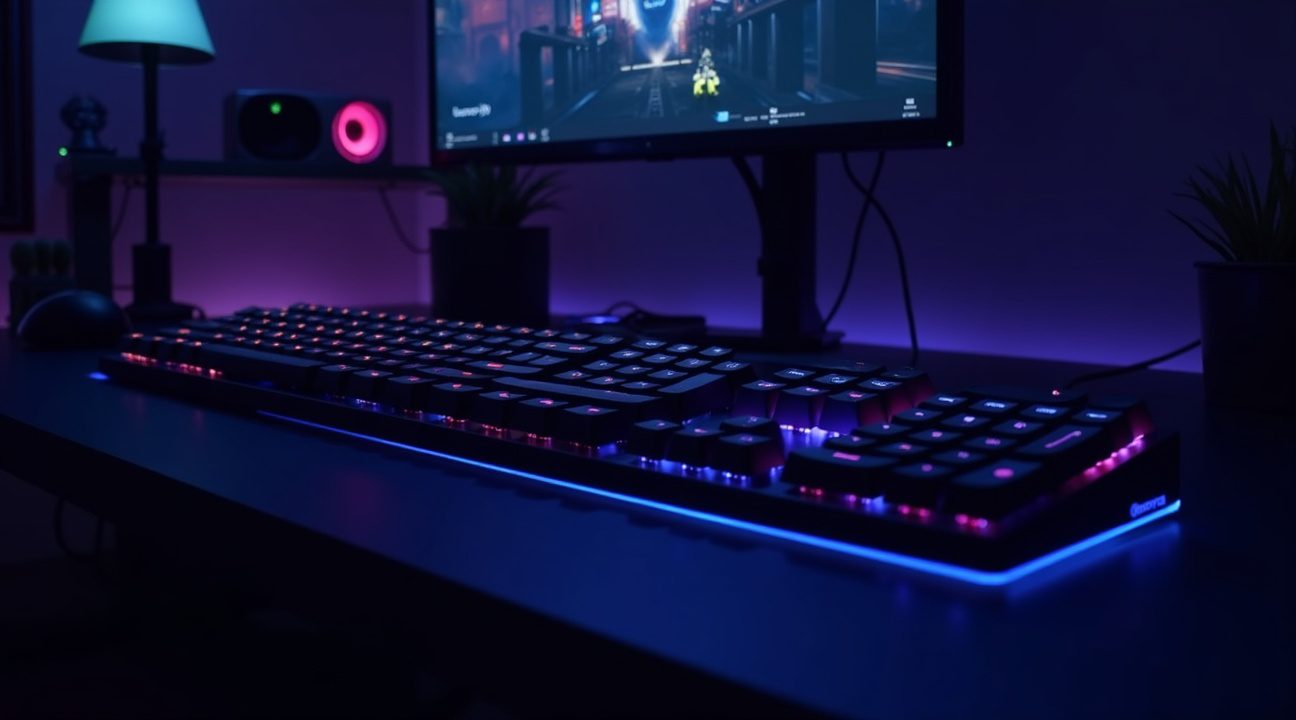
Sources:
PC Gamer – “Razer claims optical gaming keyboards are more precise than Hall effect ones because magnets are hard to control”
XDA Developers – “Mechanical vs Magnetic vs Optical Switches”
Razer – “Analog Optical Switches vs Hall Effect Switches”
RTINGS – “Mechanical Switches”

